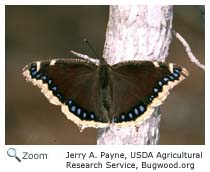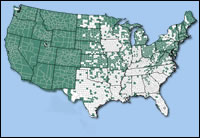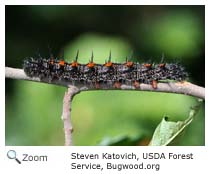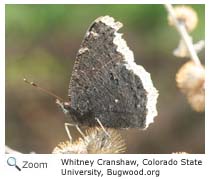Description
 The wingspan of the mourning cloak is 3 to 3.5 inches. It has
ragged and scalloped maroon-brown wings with bright blue spots and a band of yellow at the edges. The undersides of its wings are a blackish-brown edged by a brownish-yellow border. When it is at rest on a tree with its wings folded, it is perfectly camouflaged! The wingspan of the mourning cloak is 3 to 3.5 inches. It has
ragged and scalloped maroon-brown wings with bright blue spots and a band of yellow at the edges. The undersides of its wings are a blackish-brown edged by a brownish-yellow border. When it is at rest on a tree with its wings folded, it is perfectly camouflaged!
Range  The mourning cloak is found throughout North America from Canada to southern South America. It is rare in the Gulf states and in Florida. The mourning cloak is found throughout New Hampshire. The mourning cloak is found throughout North America from Canada to southern South America. It is rare in the Gulf states and in Florida. The mourning cloak is found throughout New Hampshire.
Habitat
The mourning cloak is found in sunny glades, forest borders, parks, gardens, open woodlands, streams, lakes, ponds, and groves.
|
|
Diet
 The caterpillar of the mourning cloak feeds in groups on the leaves of deciduous trees, including the willow, elm, hackberry, aspen, cottonwood, poplar, rose, birch, hawthorne, and mulberry. The adult butterfly feeds on tree sap and rotting fruit. It may also eat nectar from flowers. The caterpillar of the mourning cloak feeds in groups on the leaves of deciduous trees, including the willow, elm, hackberry, aspen, cottonwood, poplar, rose, birch, hawthorne, and mulberry. The adult butterfly feeds on tree sap and rotting fruit. It may also eat nectar from flowers.
Life Cycle
 Mourning cloaks mate in early spring. The female mourning cloak
lays pale yellow eggs in clusters on or around twigs.
The eggs are usually laid on
host trees like willow, elm, hackberry, cottonwood, poplar, rose, birch, hawthorne, and mulberry.
When the caterpillars hatch, they eat the leaves of the host plant. The caterpillars pupate and emerge as butterflies in June or July. The adult butterflies hibernate in the winter and emerges and mate in the spring. Some groups may migrate. Mourning cloaks mate in early spring. The female mourning cloak
lays pale yellow eggs in clusters on or around twigs.
The eggs are usually laid on
host trees like willow, elm, hackberry, cottonwood, poplar, rose, birch, hawthorne, and mulberry.
When the caterpillars hatch, they eat the leaves of the host plant. The caterpillars pupate and emerge as butterflies in June or July. The adult butterflies hibernate in the winter and emerges and mate in the spring. Some groups may migrate.
|



 The mourning cloak is found throughout North America from Canada to southern South America. It is rare in the Gulf states and in Florida. The mourning cloak is found throughout New Hampshire.
The mourning cloak is found throughout North America from Canada to southern South America. It is rare in the Gulf states and in Florida. The mourning cloak is found throughout New Hampshire.
